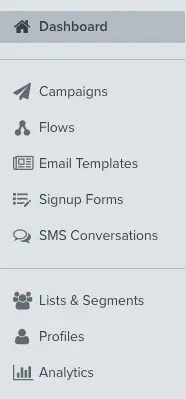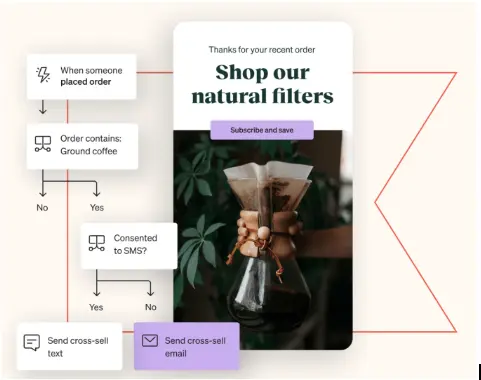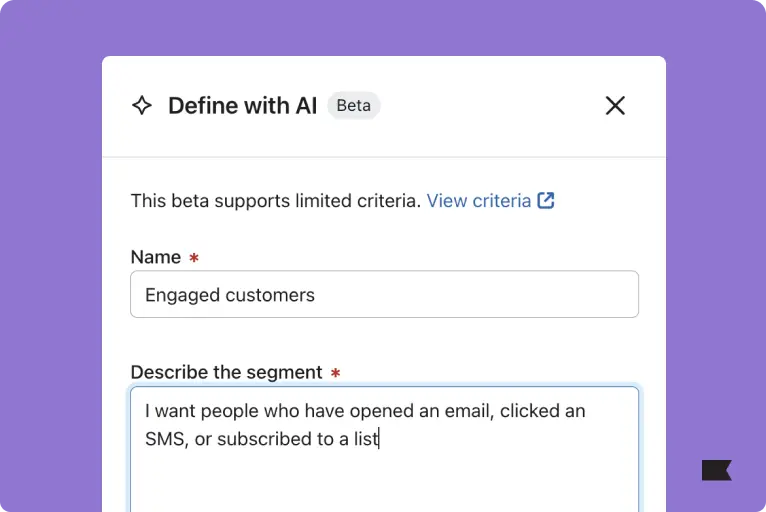Switch and scale: why you need a new Magento 2 email marketing platform—and SMS, too

So, you’re looking for a (new) email marketing platform.
Maybe you’ve been at it for a while. Maybe you even have a strong track record of doing it well. The sales emails you’re sending are working, and your profits are up. Your email list is growing.
But the platform you’ve been using is a pain in the neck. Everything takes forever. The functionality is lacking, to put it politely.
It could be that the integrations don’t work well. Glitches hold you up while you’re trying to connect with your customers.
Or you are struggling to scale personalization due to a cumbersome platform that is time-consuming to figure out. It leaves you dependent on a developer—or a small army—if you want to do something that’s actually original and unique to your brand.
Or maybe this is even your first foray into email marketing—you’ve done some email blasts here and there, and now you’re ready to level up. But of course, if you’re going to go through the trouble of switching to a new email service provider, you want to make sure you’re getting the most out of the platform you’re using.
You aren’t alone—and you likely have a lot of questions:
- How easy is the new ESP to use?
- Where will you store email addresses?
- Can you add SMS, too?
- How well will it sync with the apps you’re already using?
- How beautiful will the email templates be?
- Can you customize headers and footers, too?
- Do you need to learn html to get the most out of it?
- How well will you be able to target different segments?
Whether you’re frustrated with your current email marketing platform or a first-time shopper, if your ecommerce platform is Magento 1 or Magento 2, we’ve got good news for you. Klaviyo integrates with both and takes just minutes to set up. This integration makes it easy to personalize offers and provide new kinds of value that keep your customers loyal.
And the best part is that it’s all consolidated into one place.
In this guide, we’ll cover how and why merchants using Magento email decided to make the switch to Klaviyo, what that process entailed, and the results they’ve seen.
Using Klaviyo is “100x easier” than other platforms: here’s why
You’ve got a million tasks on your plate that should come before researching email marketing platforms. Surely, one of the motivating factors in finding a new one is to streamline you and your team’s workflow.
So, why should you consider Klaviyo?
Shane Rodgers is a director of customer success at Jamersan, an agency that focuses on developing best-in-class ecommerce websites using BigCommerce and Magento 2 for clients with complex needs. He was accustomed to working with merchants who were using Dotdigital: a robust platform, but one that carries a steeper learning curve for merchants.
The average Magento 2 merchant on Dotdigital, no matter how enthusiastic and ambitious, simply wasn’t able to make the most of the platform’s capabilities. By contrast, “with Klaviyo, the workflow management, the setting up of flows, is 100x easier” than other platforms, Rodgers says.
A transparent payment structure, and a better value than Mailchimp
He’s not alone. Melissa Welsh, an ecommerce strategist at Shero, a full-service ecommerce platform growth agency, agrees that clarity and simplicity make the platform a winner. She also touts Klaviyo’s pricing structure as not only clear, but a better value than a platform like Mailchimp.
It’s clear to Welsh—and the Magento 2 merchants she works with—how much more they get out of Klaviyo than they do with Mailchimp. Once they’re fully onboarded to Klaviyo, Welsh observes that merchants “feel like they have more visibility into what they’re paying for.”
Welsh—and other agencies like Shero—aren’t the only ones noticing the simplicity of using Klaviyo alongside Magento 2. Ruroc, a UK-based company that makes motorcycle and snow sport helmets and other best-in-class safety gear, used to use Mailchimp.
But when they tried to integrate their Magento ecommerce platform, they ran into problems. Ultimately, Ruroc decided to make a switch—and chose Klaviyo over Bronto because of how simple it was to integrate with their Magento store.
We’ve made switching from Mailchimp to Klaviyo easy
Predictive analytics: see the future
CaseᐧMate, a global mobile phone and accessories company based in Atlanta, Georgia, migrated to Magento 2 from Shopify and realized the need for a marketing automation solution that would be easy to install and maintain.
Most importantly, the new platform would need to offer flexibility with how CaseᐧMate could communicate with different customer segments over time, especially as they grew rapidly.
CaseᐧMate ended up choosing Klaviyo for its powerful product features like predictive analytics, which they needed for two main reasons: to understand future customer behavior, and to use custom property fields to collect unique data points from customers for more precise email segmentation.

In Klaviyo, Magento 2 merchants like CaseᐧMate can use predictive analytics to identify if certain groups of people are more likely than others to prefer a certain type of product. (And much more: Klaviyo’s predictive analytics can tell you everything from a predicted customer lifetime value to the probability of a customer churning.)
Fortunately, CaseᐧMate found the integration between Klaviyo and Magento 2 to be quick and easy.
“What stood out in particular was that Klaviyo had a native integration with Magento 2 that was very solid and very fast to set up,” shared Keith Neely, vice president at CaseᐧMate. “Klaviyo also adapted what we’ve put on GitHub. The entire set-up process from start to finish was a couple of weeks.”
The entire set-up process from start to finish was a couple of weeks.
Keith Neely, vice president at CaseᐧMate
Automations help you make money while you sleep
Welsh noticed that merchants with Magento stores that moved over to Klaviyo from Mailchimp or Hubspot find Klaviyo’s flows to be the best way of engaging customers without coming off too aggressively.
Welsh describes Klaviyo’s combination of follow-up emails and SMS notifications with customers as “best practice,” whereas with a third party like Attentive, a Magento merchant may be “cannibalizing their email business by sending too many things to an audience at the same time.”
One platform that does it all
Welsh says Klaviyo is perfect for Magento stores that may still be growing their general contact lists. Merchants “could be up and running and setting up flows in a week. It’s a no brainer,” she says. Once you’ve got enough contacts, you can entice them with sales emails around related products and coupon codes along with the usual order emails, order confirmations and other transactional emails.
In one example from a recent launch, Rodgers said Klaviyo’s tight integration with several other platforms primed a business to level up their abandoned cart flows, leading to major wins.
Whereas a brand may start email marketing efforts with a basic abandoned cart flow—sending 2-3 sales emails over the course of a few hours—Klaviyo gives you the ability to set up a much more robust workflow based on how much money’s worth of goods are in each abandoned cart.
For example, if a user has less than $100 in their cart, you might send them a simple reminder email. But if they have over $100 in their cart, you can offer them a 5-10% discount code to complete the sale.

Of course, Klaviyo isn’t the only platform you can use to provide coupons in your abandoned cart flow—but Rodgers and his team at Jamersan see a higher conversion rate using Klaviyo precisely because it’s so easy to set up.
“Merchants are able to experiment a lot more quickly and easily with things like coupons, and so they’re able to recover carts at a higher rate than they were able to on the previous platform,” Rodgers explains. “So, we’ve seen higher cart recovery rates with Klaviyo.”
The way Klaviyo sets up a Magento merchant to implement pop-ups can drive big results as well. Welsh reports that for one merchant she worked with, Klaviyo helped drive a roughly 30% increase in newsletter subscribers in under a month.
Klaviyo’s pop-up form—as opposed to a static newsletter sign-up option at the bottom of their homepage—was netting this small company more than 60 new newsletter subscriptions each week. Now, they’re building on that by adding an option to sign up for SMS in the same pop-up.
We’ve seen higher cart recovery rates with Klaviyo.
Shane Rodgers, director of customer success at Jamersan
Seamlessly connect to your online store and other tools
Rodgers says part of the reason he recommends Klaviyo to Magento users is the interoperability between various platforms. Different platforms work together more easily and intuitively when you’ve got Klaviyo as the bridge.
Rodgers broke it down further: a modern ecommerce tech stack includes much more than just Adobe Commerce and Klaviyo. If you want to incorporate a loyalty program and customer service into your messaging experiences, Klaviyo enables you to create much more highly personalized messaging and relationship-building based on how you’re using the other platforms.
Your secret weapon for powerful personalization
“You can leverage Klaviyo in conjunction with all these other platforms to really do some interesting things, and highly personalize your marketing,” Rodgers says.
Now, with Klaviyo’s deep integrations with Gorgias and Zendesk, you can use customer support history to drive specific, more relevant messaging for them. For instance, if you’ve seen in Gorgias or Zendesk that they have recently accessed support, you can send emails that reference or check up on their experience.
“These days, platforms are connected more easily than before to provide a holistic view of your customers,” Rodgers points out. “The way Klaviyo is set up, you don’t need a ton of development time to make the most of those connections.”
Depending on a merchant’s industry, there are varying key drivers to increasing a customer’s lifetime value. With Klaviyo, Rodgers described, you can leverage all you know around them and send them the right notifications around customer support, their purchase history, and so on. Then, you can set up an ongoing conversation with the customer to make sure you’re targeting them with the perfect offers, the right information, and the right value to continue to drive that loyalty and lifetime value.

All of the integrations Klaviyo offers, Rodgers says, enable Magento 2 merchants to really understand the interactions and touchpoints they have with their customers—and then, make informed, intentional decisions around how to use that data effectively.
Marketing power to match your growth
A great example of making those informed and intentional decisions on how to use your data comes from Ruroc. After migrating, Klaviyo’s automation library with email templates enabled Ruroc to hit the ground running, empowering them to create personalized email journeys based on customer preferences and behavior.
“The Magento integration was so simple and has immediately given us access to more customer data than we ever had with Mailchimp or than I’ve seen on any other email service platform,” says Paul Cartwright, head of CRM + web at Ruroc.
The Magento integration was so simple and has immediately given us access to more customer data than we ever had with Mailchimp or than I’ve seen on any other email service platform.
Paul Cartwright, head of CRM + web at Ruroc
By personalizing customer experiences with Klaviyo, Ruroc increased their email-attributed revenue by an astounding 80%. High engagement—an average click-through rate over 30%—came from automated email journeys based on shopper behavior.
Ultimately, Klaviyo set Ruroc up to make their sales emails much more relevant, leading Ruroc to drive 38% of all their revenue through email marketing.
“We use all the data we have—geography, onsite behavior, product interest, and more—to tailor our interactions to an incredible level,” Cartwright shares. “Our growth shows how much people appreciate it.”
Klaviyo helps Magento 2 merchants extend the customer journey
Like Ruroc, CaseᐧMate uses Klaviyo to create a communication plan that helps them reach new segments—such as iPhone vs. Android users—and deliver more relevant, meaningful messaging to customers.
And it’s working: after choosing Klaviyo, CaseᐧMate’s email open rates increased 50% and revenue grew 50% YOY. Revenue per recipient, meanwhile, increased 22%.
“The more we segment, the more success we see in general,” explains Keith Neely, vice president at CaseᐧMate. “Personalized elements make our communication more credible.”
Email is a high-converting channel for CaseᐧMate. With Klaviyo, the brand can create more extensive customer journeys. Klaviyo “helps us create new touchpoints that haven’t existed before,” Neely says. “We believe that Klaviyo has helped us and will continue to help us determine those touchpoints to extend the life of a customer.”
How easy is the migration process with Klaviyo x Magento 2?
Nobody wakes up excited to begin a migration process from one email marketing platform to another. After all, depending on the platform you’re migrating from, the process can be frustrating.
But according to Rodgers, “Klaviyo has done a really good job of building integrations with all the key ecommerce platforms and other email marketing platforms, so it’s typically easy to use what’s already been built for migration.”
Rodgers shared that the process tends to line up with the steps the merchant is usually planning in order to continue their growth, which is convenient.
To begin with, he says, it’s imperative to understand all the data sources that you’ll be migrating into Klaviyo. You’ll want to include contacts, transaction history, and any custom data about your contacts that you want to bring into Klaviyo. You’ll also want to make sure you think through which sources are bringing which data into Klaviyo.
While the process can vary depending on a number of factors, Rodgers shared that most migrations follow these steps:
- Data migration
- Flow identification and set-up
- Segment identification and set-up
- Sending initial warming campaigns
- Easing into full-fledged campaigns (by then you’re completely off your old platform)
Want an even more detailed breakdown?
Some migration processes are simple. A merchant may be setting up the integration between the email marketing platforms, pushing over all the data into Klaviyo: contacts and prior opens to begin with. After that, the merchant brings in all the transactional data from your ecommerce platform into Klaviyo. This all merges into a single view for each contact, giving you insight into prior activities around email from your previous platform, including their purchase history.
And now, you have a contact base ready to start sending meaningful, personalized messages.
What’s next? Warming activities are a great way to ensure your new email infrastructure gains a positive reputation and helps with deliverability. A few consecutive months of small campaigns with a highly engaged audience can grab your customers’ attention, make them feel seen, and keep them coming back.
Grow with the flow
Simultaneously, you can begin setting up flows from email templates in Klaviyo that support ecommerce, including abandoned cart flows, welcome series, and post-purchase series. Merchants can plan those out, design them within Klaviyo, and then look for ways to use them to expand or lengthen the customer journey.

Build your audiences your way
While some segments can get carried over from your previous email platform, they may be too basic, and with Klaviyo you can make them more robust. Some initial segmentation around prior behavior, purchase behavior, VIP customers and at-risk customers can help drive campaigns early on.
Catbird, a New York City-based jewelry company that specializes in ethically sourced handmade pieces, pivoted from storefronts to a strictly digital presence in 2020. Losing those in-person interactions between store owners and customers was a big change, and the folks at Catbird wanted to keep interactions with shoppers as personal as possible.

Looking to stand out and grow online revenue, Catbird began using Klaviyo to help “personalize and scale human experiences across digital channels,” says Justin Ragdale, VP of business development at Imagination Media. “Once data was collected from Magento, we created different audience segments in Klaviyo to automate personalized marketing campaigns.”
The results were hard to ignore. Catbird reported a 60% YOY increase in owned email revenue, a 40% YOY increase in revenue from existing customers, and a 30%+ YOY increase in new online customers.
Ragdale believes the “digital dialogue” merchants can create with Klaviyo email templates is not that different from an in-store conversation. Along with a confirmation email that replaces a friendly conversation at the cash register, a customer might receive an email featuring something they browsed, customer testimonials, or even a sizing guide. While it’s not exactly the same, the shopper still gets their questions answered.
Klaviyo x Magento: the integration that merchants and agencies alike trust
Magento brands on average achieve more than a 100x ROI with Klaviyo.
We built the most powerful integration possible for Magento, with a full sync of historical data, multi-store support (and complex catalog support, if you use bundled or configurable products), codeless signup forms, and reports on every important action and detail without limitation.
That’s not all.
Dynamic, individualized coupons, custom-built URLs that allow your shoppers to see the same cart they left behind, even from a new device, product data enrichment that automatically syncs product attributes to checkout, new orders and other order events, and catalog records—they’re all part of our powerful integration.
Even better? Klaviyo’s Magento 1 and Magento 2 extensions are certified and trusted by thousands of brands.
If you’re ready to leave your old ESP behind, follow the links to find a step-by-step resource from Klaviyo that walks you through migration process:
- How to migrate from Mailchimp
- How to migrate from Bronto
- How to migrate from Constant Contact
- How to migrate from Campaign Monitor
- How to migrate from HubSpot
- How to migrate from Listrak
- How to migrate from Sailthru
- How to migrate from Salesforce Marketing Cloud

Related content

Learn 6 ways brands use AI in marketing automation to target audiences, create content, personalize, predict churn, benchmark, and manage reviews.

Unlock the power of customer journey mapping to boost email revenue. See how mapping every touchpoint builds loyalty, retention, and lasting growth.

Discover 6 last-minute BFCM tips: optimize Klaviyo flows, re-engage buyers, protect deliverability, and schedule campaigns to maximize sales.